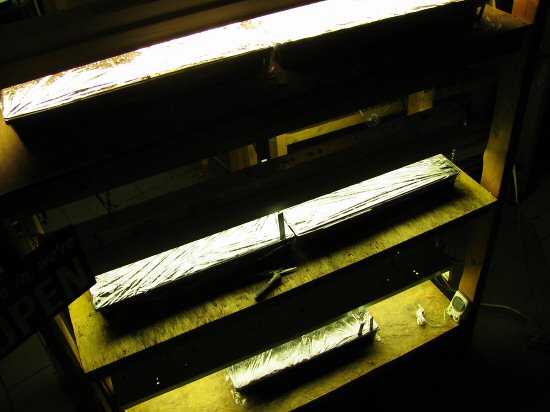- Seed starting tools
- Seed starting tools II
- Return to the trays
- Seed starting station
- The watering tray
- Bare root seed starting
- Bare root Brussels sprouts
- Editing onions, counting peppers
- Seeding as we go…
- Early spring rounds
- Plug sheet action
- True leaves
- Seedling treatment
- Grow racks in action
- Jostling tomatoes
- Seedlings continue to grow…
- Getting busy
- Grow racks at night
- 1440 onions
- To the greenhouse
- Seedlings away!
- More seedlings to the greenhouse
- Greenhouse filling up
- Early lettuce heats up
I’m sure I’ve taken this photo before, but somehow, it’s still new—the first transplants of the season! This is the look of 1,440 onions, starting out. These are 72-cell plug sheets, and the plan is to multi-plant four onions in each spot. Do a little multiplication—5 trays, 72 cells, 4 onions per—and the results are clear. Whether things will turn out exactly like this, perfect bushels of Red Globe red and Utah sweet Spanish, is anybody’s guess, but I’m quite confident we will get…something! :)
All the usual tools and methods for this tiny farm are back for another run. There are still at least a couple of years left on the roll of donated food-grade plastic wrap that I use (and re-use for the season) to hold moisture and increase heat, just until the tiny seedlings emerge. To check temperatures in this new seedling room, on the lowest shelf of the light rack, where it’s coldest, is one of the minimum/maximum digital recording thermometers. And of course, there are the trusty, home-built light racks themselves, with an assortment of T-12 and T-8 fixtures and Cool White fluorescent tubes, providing the bare minimum of heat and light to get things started.
I’m always up for trying new approaches and new gear, but a lot of the time, if it gets the job done and you’re already having fun, what more could you need?!





Good grief…wish I was your neighbor when all those beauties are ready to harvest.
Christine in Alaska
That is a lot of onions. Im growing onions from seed for the first time and I found very interesting your post on multi planting – it does work!
Mike,
Thanks for the blog post! very exciting to see the season get rolling. Will also be looking for updates through the season on the cluster planting of the onions, a technique I want to try next year as we are not planting onions from seeds this year.
Thanks
Eric
looks great! we’re growing zone 5 also, and after my husband found your blog last year, you’ve inspired us to do more and do it better! keep up the great work, and keep those posts coming…
Welcome back – hope you had a fabulous winter!
Gosh, I’m glad to see your spring posts start up!
I just did the same thing – 6 trays of onions, yahoo! But I only did 4-5 seeds for the bunching varieties and 2 for the bulbing ones. The disadvantage is that it means a lot more trays, but I wasn’t sure if the spanish varieties would be crowded?